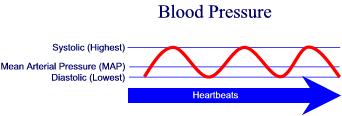 This is the Archived Desktop Edition.
This is the Archived Desktop Edition.
You should be transferred to the Newest Edition for Desktop and Mobile within 2 seconds.
Lesson 5: Blood Pressure
5-2
5-2. WHAT ARE SYSTOLIC AND DIASTOLIC PRESSURES?
 |
Basically, the systolic pressure is the greatest pressure that the blood exerts against the walls of the blood vessel while the diastolic is the lowest pressure that the blood exerts against the walls of the vessel. A person's blood pressure depends upon the force of the heart's pumping action, the degree to which the blood vessel will stretch, and the amount of blood in the blood vessel.
a. Systolic. The arteries are under the greatest pressure when the heart pumps blood into them. The
extra blood that is forced into the arteries make them stretch.
(1) In a normal adult male, the systolic pressure should be between 100 and 140 mm Hg, inclusive. (Inclusive simply means to include the ends of the range. Systolic pressures of 100 and of 140 are within normal range.)
(2) In a normal adult female, the systolic pressure should be between 90 and 130 mm Hg, inclusive.
b. Diastolic. The arteries are under the least pressure from the blood when the heart is at rest (between pumps or beats) and the arteries have returned to their normal size.
(1) In a normal adult male, the diastolic pressure should be between 60 and 90 mm Hg, inclusive.
(2) In a normal adult female, the diastolic pressure should be between 50 and 80 mm Hg, inclusive.
